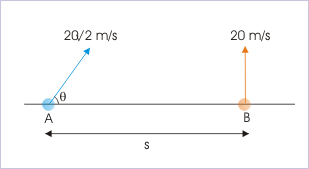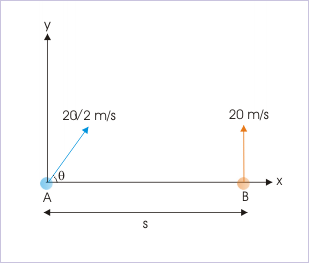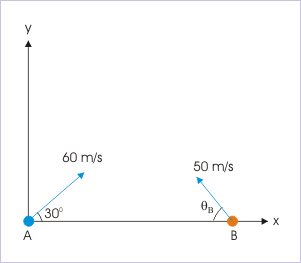| << Chapter < Page | Chapter >> Page > |
If “ ” is the initial separation between projectiles, then for collision they should cover this separation with y-component of relative velocity. Since two projectiles are initiated at the same time instant, the time when collision occurs is given by :
where is the relative speed of approach of A with respect B. Note that time expression evaluates to same value whether we compute it with or . On the other hand, if there is no initial separation in y – direction, the projectiles should cover same vertical distance for all time intervals. It is so because projectiles have to reach same vertical i..e y-position at the point of collision in two dimensional space. This means that relative velocity of projectiles in y-direction is zero for the condition of collision. Mathematically,
In this case, there is no initial vertical separation. Such is the case, when projectiles are projected from same horizontal level. Both projectiles should rise to same height for all time. Clearly, relative velocity in vertical i.e y-direction is zero :
On the other hand, time of collision is obtained by considering relative motion in x-direction :
There are different cases for projection from the same horizontal level. Some important cases are : (i) one projectile is projected at certain angle to the horizontal while the other projectile is projected vertically and (ii) Both projectiles are projected at certain angles to the horizontal. Here, we shall work out examples for each of these cases.
Problem : Two projectiles “A” and “B” are projected simultaneously as shown in the figure. If they collide after 0.5 s, then determine (i) angle of projection “θ” and (ii) the distance “s”.
Relative motion

Solution : We see here that projectile “A” is approaching towards projectile “B” in horizontal direction. Their movement in two component directions should be synchronized so that they are at the same position at a particular given time. There is no separation in vertical direction at the start of motion. As such, relative velocity in y-direction should be zero for collision to occur.
Relative motion

In the x-direction, the relative velocity is :
The distance “s” covered with the relative velocity in 0.5 second is :
Problem : Two projectiles “A” and “B” are thrown simultaneously in opposite directions as shown in the figure. If they happen to collide in the mid air, then find the time when collision takes place.
Two projectiles

Solution : There is no separation in vertical direction at the start of motion. As such, relative velocity in y-direction should be zero for collision to occur.
Putting values,
The projectiles move towards each other with the relative velocity in horizontal direction. The relative velocity in x-direction is :
In order to find relative velocity in x-direction, we need to know “ ”. Using trigonometric relation, we have :
Hence,
We should now understand that projectiles move towards each other with a relative velocity of 92 m/s. We can interpret this as if projectile “B” is stationary and projectile “A” moves towards it with a velocity 92 m/s, covering the initial separation between two particles for collision to take place. The time of collision, therefore, is :

Notification Switch
Would you like to follow the 'Physics for k-12' conversation and receive update notifications?